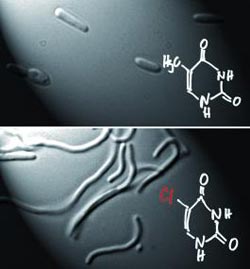Modified Genetic Alphabet

Evolution is based on heredity, changes to the genetic material (mutation), and the natural selection of those organisms that are best suited to the given environmental conditions.
An international team led by Rupert Mutzel at the Freie Universität of Berlin has now successfully emulated one particular evolutionary process in the laboratory. As the researchers report in the journal Angewandte Chemie, they were able to generate a bacterial strain whose genetic material contains an artificial building block in place of a natural one. Their success results from a special automated cultivation technique.
DNA, the carrier of the genetic information of all cells, is based on a code consisting of four “letters”, the bases adenine, cytosine, guanine, and thymine. Thanks to their new artificial evolution process, the scientists have now been able to grow bacteria in which the thymine of DNA has been replaced with an analogue, the base 5-chlorouracil. This synthetic component is poisonous to other organisms.
The researchers started with a genetically modified strain of the bacterium Escherichia coli that is no longer capable of producing thymine. These microorganisms were cultivated over many generations in the presence of increasing amounts of chlorouracil in a specially built apparatus. Whenever the size of the population sank below a certain level, the bacteria were given a brief dose of a chlorouracil-free, thymine-containing medium to give them a chance to recover. The concentration of chlorouracil was automatically increased whenever genetic variants of the bacteria that better tolerated this substance were produced. In this way, the cells were always exposed to a quantity of chlorouracil that was just barely tolerable. After about 1000 generations, the microorganisms had adapted to the altered environmental conditions, that is, the presence of chlorouracil instead of thymine. They were able to build up their DNA with chlorouracil in place of thymine. Analysis of the genome showed that the process of adaptation resulted in many changes to the genetic material of the bacteria.
“Our results demonstrate the success of our evolutionary cultivation strategy,” says Mutzel. “In this way it should be possible to develop microorganisms that can convert chemical intermediates to pharmaceuticals or break down environmental pollutants.” Microorganisms that have DNA with synthetic building blocks may also be useful in hindering the spread of purposely or accidentally released modified cells in the environment. Such microorganisms would also be incapable of exchanging genes with their natural relatives.
Author: Rupert Mutzel, Freie Universität Berlin (Germany), http://www.biologie.fu-berlin.de/arbeitsgruppen/mikrobiologie/ag_
mutzel/personen/professoren/rupert_mutzel/index.html
Title: Chemical Evolution of a Bacterium's Genome
Angewandte Chemie International Edition 2011, 50, No. 31, 7109–7114,
Permalink to the article: http://dx.doi.org/10.1002/anie.201100535
Copy free of charge. We would appreciate a transcript of your article or a reference to it.
The original article is available from our online pressroom at http://pressroom.angewandte.org
Media Contact
More Information:
http://pressroom.angewandte.orgAll latest news from the category: Life Sciences and Chemistry
Articles and reports from the Life Sciences and chemistry area deal with applied and basic research into modern biology, chemistry and human medicine.
Valuable information can be found on a range of life sciences fields including bacteriology, biochemistry, bionics, bioinformatics, biophysics, biotechnology, genetics, geobotany, human biology, marine biology, microbiology, molecular biology, cellular biology, zoology, bioinorganic chemistry, microchemistry and environmental chemistry.
Newest articles

Recovering phosphorus from sewage sludge ash
Chemical and heat treatment of sewage sludge can recover phosphorus in a process that could help address the problem of diminishing supplies of phosphorus ores. Valuable supplies of phosphorus could…

Efficient, sustainable and cost-effective hybrid energy storage system for modern power grids
EU project HyFlow: Over three years of research, the consortium of the EU project HyFlow has successfully developed a highly efficient, sustainable, and cost-effective hybrid energy storage system (HESS) that…

After 25 years, researchers uncover genetic cause of rare neurological disease
Some families call it a trial of faith. Others just call it a curse. The progressive neurological disease known as spinocerebellar ataxia 4 (SCA4) is a rare condition, but its…





















